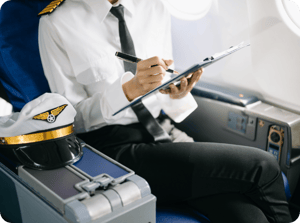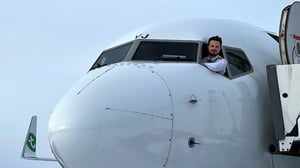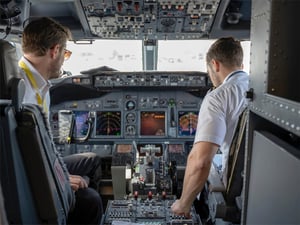
Assess your knowledge: Correct Answers
Check out the correction
| ❌ 10-30 kg of fuel per flight | ✅ 30-70 kg of fuel per flight | ❌ 70-100 kg of fuel per flight |
By applying the Continuous Descent Approach, a single-aisle aircraft such as the A320 or B737 will save between 30 and 70 kg of fuel per flight. For larger aircraft, the benefit can exceed 250 kg.As an example, let’s take an airline operating a fleet of only 20 single-aisle aircraft flying 6 flights a day: since a Continuous Descent Approach allows to save around 50 kg per flight, this will result in more than 2 million kg of fuel saved per year (or more than 700,000 gallons), which represent a significant cost.
| ✅ Engine cool-down time | ❌ Engine warm-down time |
To preserve engine life, it is very important to respect the engine cool-down time prescribed by the manufacturer before shutting down an engine.As a consequence, Engine-Out Taxi-In is only applicable when taxi-in duration is longer than engine cool-down time.
| ❌The impossibility of flying a specific route. | ✅ A shortcut between two waypoints of the flight plan. | ❌ A limitation between two waypoints. |
A direct is a shortcut between two waypoints of the flight plan. For example, on the image below, the standard routing would be to follow the flight plan’s different waypoints, but a direct can be flown from waypoint RAVIA to waypoint TAHAR. By taking this direct route, the aircraft saves time and fuel.
| ✅Save fuel | ✅Reduce noise | ✅ Enhance passenger comfort | ❌ Save brakes |
| ❌ 3–5 kg | ✅ 7–10 kg | ❌ 15-20 kg | ❌ 25 kg |
A single-aisle aircraft such as the A320 or B737 can save between 7 to 10 kg of fuel per flight by applying this best practice.
For larger aircraft, the benefits can exceed 25 kg per flight.
| ❌ To achieve a faster takeoff speed. | ❌To reduce the overall weight of the aircraft. | ✅ To extend the engine's operational lifespan and decrease maintenance costs. |
One of the main reasons to use the minimal thrust required at takeoff is to reduce maintenance costs. Regular reduced thrust takeoff applications yield significant cost savings for an airline.
By decreasing internal engine temperatures and the exhaust gas temperature (EGT) at takeoff, it reduces engine wear resulting in a longer engine on-wing life. Most engine wear will occur at the highest temperatures, and a 1% reduction from full take-off thrust will result in a 10% saving in engine life, as the last few degrees are the most damaging. Therefore, less maintenance is required as the engine may achieve more flight cycles between two maintenance actions.
The cost savings depend on the engine type and several other factors, like labor cost and engine age. However, according to the IATA, using reduced thrust instead of full thrust during takeoff saves about 150 US$ per engine and per takeoff.
| ❌ Less than 10 kg/hour | ✅ Less than 20 kg/hour | ❌ About 50 kg/hour | ❌ Similar to the APU |
According to United Continental, APU uses 150 to 400+ kg of fuel per hour, while Ground Power Units (GPU) provided by the airport use less than 20 kg of fuel per hour.
| ❌ Engine temperature |
❌ Cabin pressure | ✅Drag and aerodynamic efficiency | ❌ Passenger comfort |
When the acceleration starts at this lower height, the plane can switch to the efficient flight mode more quickly and reduce drag. This means it faces less resistance from the air, making it more efficient. In most cases, the altitude is reduced from 3000ft to 800ft. For lighter aircraft, it can go down to 400ft.
| ❌ NADP1 | ✅ NADP2 |
In red, the usual NADP1 procedure, where the aircraft accelerates at 3000ft
In green, the perfect application of Reduced Acceleration Altitude, where the aircraft accelerates at 800ft. It is equivalent to NADP2 procedure.
| ❌ 1.5% |
❌ 2.0% | ✅3.5% | ❌ 5% |
The unused extra fuel, which remains at landing, had to be carried during the whole flight and increased the fuel consumption by increasing the aircraft's weight. To compute the impact of carrying this fuel, you must multiply the unused aircraft fuel by the cost of weight (CoW) or cost of carrying the fuel.
A good rule of thumb for computing the cost of weight is to consider that it represents about 3.5% of the flight hours.
For example, 1Tone of extra fuel remaining after a flight of 3 hours will have cost 105kg of additional fuel to carry to destination.
Courses and insights designed for pilots seeking to optimize flight operations
- Build and sharpen your skill for flying tomorrow.
- Optimize safety and efficiency without changing how you fly.
- Understand the fuel impact of operational choices.
- Continuously improve through real-world insights.
- Stay ahead of evolving industry expectations and regulations.

Quick, interactive and certifiying module to master practical strategies to minimize fuel consumption and reduce CO2 emissions.
Quick, interactive and certifiying module to master practical strategies to minimize fuel consumption and reduce CO2 emissions.

Articles and white papers full of insights and practical tips to stay aligned with emerging industry standards.
Articles and white papers full of insights and practical tips to stay aligned with emerging industry standards.

Explore expert interviews, opinion pieces, and trend analyses from within the pilot community.
Explore expert interviews, opinion pieces, and trend analyses from within the pilot community.



.png?width=600&height=343&name=Reduce%20Acceleration%20Altitude%20(NADP%201%20vs%20NADP%202).png)